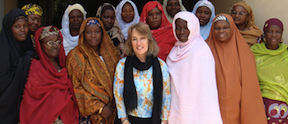 The pro-life v. pro-choice debate continued on the House floor yesterday as party representatives grappled with sustaining women’s reproductive rights in a surfacing abortion bill. On Tuesday, the House of Representatives approved a bill banning a woman’s right to pursue an abortion after 22 weeks of pregnancy, subtracting two weeks off the current cut-off of abortions at 24 weeks in utero. The majority-Republican party passed this bill shaving off the extra two weeks based off the medically disputed theory that a fetus is capable of feeling pain 20 weeks after conception (which is equivalent to 22 weeks of pregnancy). Democrats in the House and the White House fought against the bill, saying the legislation is an “assault on a woman’s right to choose” and is an attempt to undermine the precedent set in the 1973 Roe v. Wade trial.
The pro-life v. pro-choice debate continued on the House floor yesterday as party representatives grappled with sustaining women’s reproductive rights in a surfacing abortion bill. On Tuesday, the House of Representatives approved a bill banning a woman’s right to pursue an abortion after 22 weeks of pregnancy, subtracting two weeks off the current cut-off of abortions at 24 weeks in utero. The majority-Republican party passed this bill shaving off the extra two weeks based off the medically disputed theory that a fetus is capable of feeling pain 20 weeks after conception (which is equivalent to 22 weeks of pregnancy). Democrats in the House and the White House fought against the bill, saying the legislation is an “assault on a woman’s right to choose” and is an attempt to undermine the precedent set in the 1973 Roe v. Wade trial.
The argument quickly split down party lines (only six party members from each side voting against their party) and escalated into a debate on women’s reproductive rights. In this heated bipartisan debate, representatives from both sides evoked emotional appeals. Though different in message, consistent across both lines is the lack of the female voice. While the House attempted to integrate more women in this debate, only 19 of the 222 Republican House members who voted for this bill are women. In total, the House of Representatives only has 78 women, accounting for a meager 18% voice in the House. Furthermore, there are no Republican women on the Judiciary Committee panel that has jurisdiction over this particular legislation.
While this bill certainly made headlines, the threat of it obtaining further approval is low. Sources agree that the bill will not find support in the Democrat-controlled Senate, and President Obama has also already voiced his opposition. Although no abortion laws are changing today, it is important to keep abreast on the dialogue surrounding this controversial and emotional topic. Most importantly, government representatives must do a better job of allowing women’s voices and opinions to be heard. Female reproductive rights issues have been considered taboo for too long, and an open dialogue in the government may help bridge the gap between women and policy.
Sources: ABC News, USA Today, and The New York Times.

 Geneticists, researchers, and patients joined in celebration over last week’s unanimous Supreme Court ruling involving the BRCA1 and BRCA2 genes, colloquially referred to as the “breast cancer genes.” The Supreme Court ruled that Myriad Genetics could not patent the BRCA1 and BRCA2 sequence of genes, because patents cannot be placed on that which is created organically in nature. This decision opens the door for researchers outside of Myriad Genetics to study these genes, providing more opportunities to discover early signs of breast cancer susceptibility. Karuna Jaggar, Breast Cancer Action’s Executive Director reported that this ruling was, “a tremendous victory for women with a known or suspected inherited risk of breast cancer. Today, the Court righted a wrong and has put patients’ health before corporate profits.”
Geneticists, researchers, and patients joined in celebration over last week’s unanimous Supreme Court ruling involving the BRCA1 and BRCA2 genes, colloquially referred to as the “breast cancer genes.” The Supreme Court ruled that Myriad Genetics could not patent the BRCA1 and BRCA2 sequence of genes, because patents cannot be placed on that which is created organically in nature. This decision opens the door for researchers outside of Myriad Genetics to study these genes, providing more opportunities to discover early signs of breast cancer susceptibility. Karuna Jaggar, Breast Cancer Action’s Executive Director reported that this ruling was, “a tremendous victory for women with a known or suspected inherited risk of breast cancer. Today, the Court righted a wrong and has put patients’ health before corporate profits.” Policy changes are necessary to decrease the death rate of pregnant women in developing countries. Research, according to Dr. Stacie E. Geller, does not end once scientists publish. The true battle is implementing that research to affect global change. Dr. Stacie E. Geller, Director of the Center for Research on Women and Gender at the University of Illinois at Chicago College of Medicine, puts research into practice by providing safe, affordable medication to pregnant women in developing countries. Dr. Geller spoke last week at a forum held at Northwestern University's Feinberg School of Medicine and presented her research on Postpartum Hemorrhaging (PPH) and its dangers to women in developing countries.
Policy changes are necessary to decrease the death rate of pregnant women in developing countries. Research, according to Dr. Stacie E. Geller, does not end once scientists publish. The true battle is implementing that research to affect global change. Dr. Stacie E. Geller, Director of the Center for Research on Women and Gender at the University of Illinois at Chicago College of Medicine, puts research into practice by providing safe, affordable medication to pregnant women in developing countries. Dr. Geller spoke last week at a forum held at Northwestern University's Feinberg School of Medicine and presented her research on Postpartum Hemorrhaging (PPH) and its dangers to women in developing countries. Did you know that most adverse drug side effects that are reported are done so by women? This is why we advocate so strongly for the inclusion of males AND females in all animal and human drug studies. It's important that consumers report any bad experiences to the FDA!
Did you know that most adverse drug side effects that are reported are done so by women? This is why we advocate so strongly for the inclusion of males AND females in all animal and human drug studies. It's important that consumers report any bad experiences to the FDA! Think men and women receive equal care after traumas? Think again. A recent study found that women are less likely than men to receive trauma treatment after severe injuries. Dr. Andrea Hill of the Sunnybrook Health Sciences Centre and the University of Toronto’s research on gender-based inequalities found that, across all age groups, 20-30% fewer women are cared for after traumas. The study and analysis were conducted by observing 99,000 adult patients throughout Canada. After controlling for demographic and socioeconomic factors, Hill and her colleagues were shocked at such disproportions between male and female patient care. Hill affirms that “gender-based disparities in access to health care services in general have been recognized for some time,” and she calls for further research into the underlying factors involved in these gender gaps.
Think men and women receive equal care after traumas? Think again. A recent study found that women are less likely than men to receive trauma treatment after severe injuries. Dr. Andrea Hill of the Sunnybrook Health Sciences Centre and the University of Toronto’s research on gender-based inequalities found that, across all age groups, 20-30% fewer women are cared for after traumas. The study and analysis were conducted by observing 99,000 adult patients throughout Canada. After controlling for demographic and socioeconomic factors, Hill and her colleagues were shocked at such disproportions between male and female patient care. Hill affirms that “gender-based disparities in access to health care services in general have been recognized for some time,” and she calls for further research into the underlying factors involved in these gender gaps. I think women want to feel independent, that we can conquer the world on our own. Sometimes it can be hard to ask for help.
I think women want to feel independent, that we can conquer the world on our own. Sometimes it can be hard to ask for help. Did you know that 15% of women are diagnosed with Hypoactive Sexual-Desire Disorder (
Did you know that 15% of women are diagnosed with Hypoactive Sexual-Desire Disorder ( Breasts—especially those that scale towards the large end of the spectrum—are often named as a scapegoat for back pain in women. However, it’s likely that much of the blame is misplaced. This misdirected implication could be leading women to false self-diagnoses and even unnecessary medical procedures.
Breasts—especially those that scale towards the large end of the spectrum—are often named as a scapegoat for back pain in women. However, it’s likely that much of the blame is misplaced. This misdirected implication could be leading women to false self-diagnoses and even unnecessary medical procedures. A significant number of parents are not allowing their daughters to receive the
A significant number of parents are not allowing their daughters to receive the